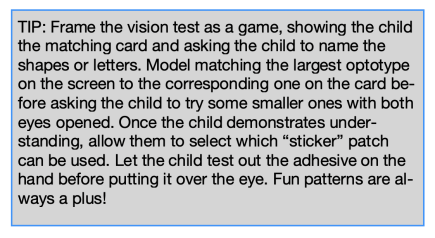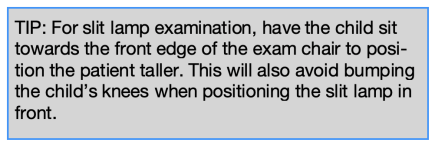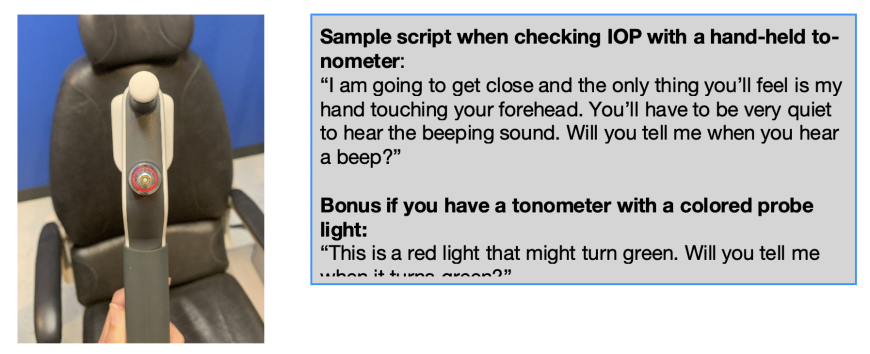Tiffany Yanase Park, OD, FAAO
Loma Linda University
Going to the optometrist’s office can cause many different feelings for a child. Even if your office is not furnished with fun themes, the child’s perception and experience of the visit can be positively shaped by you. Every component of the eye exam has value, and it is important to test to the highest level achievable. With trust and reason to engage, children can surprise you with the extent of their participation.
Visual acuity:

Testing visual acuity requires different approaches and methods depending on the age and cooperation of the child. To test the highest level of vision, charted visual acuity tests are used, which involves seeing the letter or symbol and then identifying it by matching or verbalizing what is seen. Snellen and Sloan visual acuity charts, which include identifying letter optotypes, are the most accurate measurements of a child’s vision.1 However, for younger children who may not know all of their letters or are apprehensive with the test, LEA symbols or HOTV charts are also accurate and reliable tests to use.2 Both are a four-alternative forced choice test with equally legible optotypes and have a corresponding matching card. The available evidence does not support the use of other picture charts, such as Allen figures and Patti Pics, for accurate acuity measurement since they do not comply with the parameters of optotype design.1,3 Orientation optotypes, like the Tumbling E or Landolt C, are alternatives, but have the confounder of right-left directionality, which could be challenging for the younger patient.
When possible, linear presentation of optotypes should be used to obtain the most accurate measurement of visual acuity and avoid overestimating acuity when amblyopia is present.1 The use of “crowding bars” can be supplemented when single optotype presentation is necessary to avoid overestimation for children with amblyopia as well.1
Other pre-testing:
Testing the child’s ocular alignment gives much insight into how the eyes work together. Stickers of popular TV shows or movies can serve as interesting targets when performing cover test. Marvel, Encanto, CoCoMelon, Pink

Fong, and Paw Patrol characters are always great helpers during the eye exam. If the child brought a toy or a doll, that can also be a familiar and excellent fixation target. Even a goofy cap to your transilluminator can work well!
Confrontation visual fields can also be tested in children; however, many times the patient will have difficulty keeping the eyes centrally fixated. When this occurs, the child can stare at an interesting central object, such as a sticker or light up toy, while a peripheral object is slowly presented to the patient’s line of sight.1 When the child makes an eye movement towards the incoming peripheral object (an evoked saccade), it confirms the visual field acuity.1 This can be completed in different quadrants to examine the patient’s visual field range. Make sure to use objects without noise, as we should only be testing the patient’s eyes for this test and not their ears!
Children will generally engage in a test if it is creative and exciting. Therefore, examining the anterior segment with a slit lamp can often be achieved if it stimulates the patient’s imagination. By pretending the handle bars are “motorcycle or bicycle bars”, the chin rest is a “chin pillow”, and the head rest is a “head band”, the child may understand the proper head positioning for the exam and allow for evaluation.1 Additionally, children may sit on a guardian’s lap if they are apprehensive or unable to reach the chin rest. This will also allow the guardian to assist in positioning the head properly and keeping the head steady throughout the exam. The use of finger puppets, stickers, or a movie behind the examiner can also keep the child’s fixation steady. For children who are unable to complete the slit lamp evaluation, using a 20 diopter lens to magnify the eyes can be used in conjunction with a transilluminator or ophthalmoscope to examine the anterior portion.

Any testing that involves a device can be intimidating for children - a hand-held tonometer or auto-refractor can be many scary things with a creative imagination! Ease a child’s anxiety by demonstrating the test on a parent or from a distance. Calmly explaining what you will be doing can level a child’s expectations.
Dilation drops
This part of the exam might have been at the forefront of the child’s mind (or even the parent’s), even before arriving to the clinic. We know that dilation is necessary for a pediatric comprehensive eye exam, so it is crucial to communicate to the parent about its importance and also its side effects. Once the parent is on the same page, I speak directly to the child about the next steps. The parent may claim that “it is just water”; however, I am an advocate for honesty, so I will describe how the drops might feel and how the child might see thereafter. It is an opportunity to establish credibility and trust with the child, which will be needed for the subsequent parts of the examination. The instillation of the drops should be done swiftly and effectively. I recommend putting drops directly in the eye versus letting them blink them in, lest you come back after the waiting period only to find that the drops need to be used again.

Refractive error and ocular health
Fortunately, you can reassure the child that you are only using flashlights from here! A flashlight you hold (retinoscope), a flashlight with a shelf (slit lamp), and a flashlight hat (indirect ophthalmoscope) - all doable, right? These objective measurements are critical for your assessment and plan. I give the child the game plan, and at this point, it is a fine balance of entertaining to maintain cooperation and obtaining reliable data. If there is not a movie to watch at the end of the lane, a (dancing) parent standing behind you can keep a child’s gaze. Light up toys are great for this portion in dim room lighting because they easily redirect a child’s attention in different directions, especially for the posterior segment exam. Breaks are acceptable if a child’s endurance is waning, but encouragement and praise can help everyone get to the finish line.

Wrapping up
There’s a psychological concept called the peak-end rule, whereas the child will remember the peak (most intense part) and the end of an experience. Therefore, by rewarding a child with a small prize, such as a sticker, sunglasses, or a trip to the treasure chest, can leave a lasting favorable impression for the patient after accomplishing the exam. Confirming parental permission to provide a prize may be necessary, particularly if candy (sugar-free hopefully) is involved.
The early years are formative for a child’s development, so your exam will help fully understand the child’s vision, eye health, and how the eyes work together. Giving the child ownership in small decisions, as well as showing and telling the child what will be done can clear the fear. You may need your discretion to modify some portions in order to save the child’s best cooperation for the consequential parts of the exam. Sometimes you need to simplify the exam completely to “trope-trop-and-scope” - check for strabismus, dilate the eyes, and obtain your objective measurements. However, with the right amount of friendliness and technique, the pediatric eye exam can be (mostly) enjoyable and memorable for everyone involved.
References
1. American Academy of Ophthalmology. 2017-2018 Basic and Clinical Science Course (BCSC), Section 6: Pediatric Ophthalmology and Strabismus. 2017.
2. Vision in Preschoolers (VIP) Study Group. Effect of age using LEA symbols or HOTV for preschool vision screening. Optom Vis Sci. 2010 Feb;87(2):87-95.
3. Anstice NS, Thompson B. The measurement of visual acuity in children: an evidence-based update. Clin Exp Optima. 2014 Jan;97(1):3-11.





